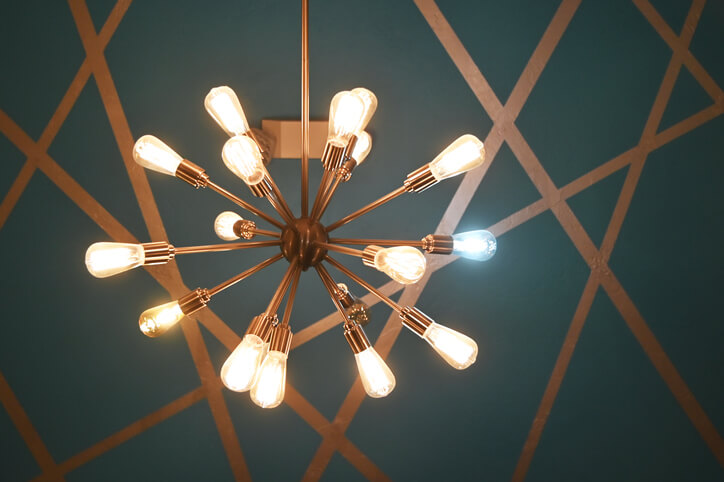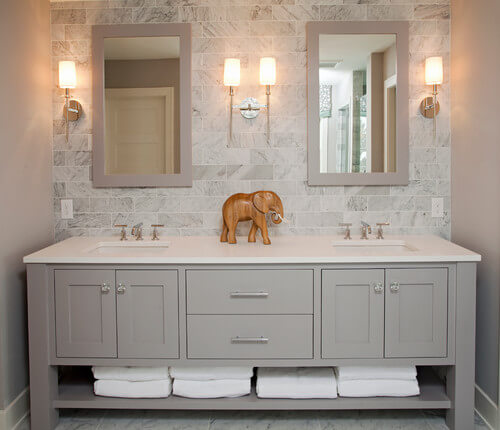Do you always feel like something is missing in your perfectly designed space? If so, it’s probably the lighting. Proper lighting complements your décor, creating a welcoming ambiance. It also enhances your home’s usability and can even help you reduce utility costs. You’ll notice a significant difference when you utilize the below lighting ideas in your home to improve lighting in your space.
How to Improve Lighting in Your Home
The types of lights you opt for and where you install them can make or break the personality of your space. Here are seven simple but brilliant lighting ideas to use in your home.

You might think chandeliers are old school but there are plenty of modern designs you can find these days.
1. Select a Centerpiece
Choosing one unique lighting fixture (for instance, a massive but stunning crystal chandelier) and working the rest of the lighting around tie your décor together. Suppose you have a relatively neutral or minimalist scheme, opt for an eye-catching, bold lighting centerpiece to serve as a focal point.
2. Layer Your Lights
There are three layers of lighting: ambient, task, and accent lighting. Each layer provides a unique effect.
Ambient lighting offers an overall glow, setting the tone for a room. Task lighting, on the other hand, is concentrated and meant to help you see through routine tasks. Accent lighting is very concentrated and mainly casts a glow on focal points, like artwork. Play around with all three for a cozy, layered designer look.
If you own a large open kitchen, you could install downlights as task lighting over the work areas, smaller downlights for ambient lighting, and pendants over the dining area for accent and ambient lighting. This breaks up your large open kitchen into smaller intimate zones for a welcoming, well-balanced effect.
The secret to getting layering right is understanding the purpose of each lighting fixture. For instance, accent lighting such as undercabinet lights is best used on kitchen work counters because they concentrate light on a single area.

Wall sconces are great for ambient light. However, they might not be the best sole lighting in a bathroom. Think layers. With this look, also consider having recessed lighting up above.
3. Prioritize Function
Before you light a room, consider how you plan on using the space to determine the right lighting fixtures for it. For instance, you’ll need portable table-side lamps for task lighting in reading rooms. But for living areas, play around with ambient, task, and accent lighting options.
4. Change the Angle
The design of a lighting fixture also affects how it disperses light. For instance, a dark pendant shade directs lights up and down for task lighting, while a light shade provides a uniformed outward glow for ambient lighting. Instead of regular lighting fixtures, opt for directional lighting fixtures for that extra oomph.
5. Consider the Room’s Scale and Proportion
You don’t want to spend your afternoon shopping for good lighting, only to find out what you picked out is too small to make any difference or too big, making it overpowering.
Your lighting fixtures should be big enough to be noticeable but not overpowering and not too small – they get lost in the scheme of your space’s décor. For instance, if your room is big and airy, group a few pendants you like to create an impact or opt for a super-sized statement chandelier for that wow factor.
6. Reflect Light
Combine carefully selected lighting fixtures with polished metals, angled spotlights, or mirrors to intensify lighting and add an extra sparkle to your space. It also makes a room feel brighter and airy.
7. Choose the Right Bulb
Your bulb use doesn’t just impact your energy bill – it also affects the mood of a room. For instance, a bulb with a warm glow warms up a room with cooler tones, while a bulb with a cool glow often brightens up a dark space.
Transform Your Living Space with Better Lighting
Proper lighting adds personality and individuality to any space. Ready to elevate your home using the lighting ideas above? Work with our experts today to improve lighting in your home, creating a perfect atmosphere for your décor to shine.
